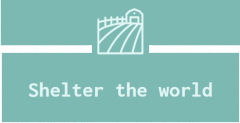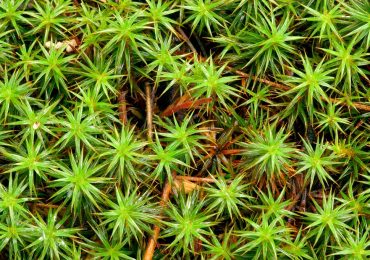In this week’s blog post, Dr. Russell Bonduriansky, professor at University of New South Wales, discusses the story behind the cover for 2016’s Volume 30, Issue 10 of Functional Ecology. Russell has broad interests in evolutionary ecology, but is especially interested in the evolution of sexual reproduction and coevolution of the sexes, life history (especially ageing), and the role of nongenetic hereditary processes in evolution. His team conducts empirical research in the lab and in natural populations, and also develops theory. This blog is part of our brand new series – Cover Stories! Read on to learn about one of our amazing cover images, the research behind it, and the people too.
About the Cover Photo
What does your cover photo depict and what research led you to it?
I moved to Australia shortly after completing my PhD, with grand plans to do my postdoctoral research on a certain Australian fly with an interesting sexual dimorphism. But my original fly of choice proved difficult to work with. I was unfamiliar with the local fauna and struggled to find a suitable alternative. My infant son came to the rescue. He cried a lot, and the best way to calm him was to put him in the front-carrier and go on long walks. I spent several months marching around Sydney’s Eastern Suburbs with him dangling in front of me. One day, as I carried him along a boardwalk that snaked through a small forest reserve, I noticed strange, beautiful flies with long legs and heads sitting along the wooden railing. An entomologist at the Australian Museum identified those flies for me as neriids. They had never been studied before, but I captured some to see if I could get them to breed, and set them up in containers filled with different mixtures of rotten vegetables on my desk in the shared postdoc office. Initial attempts proved unsuccessful (too much water!), but I eventually figured out that the larvae would do well if the vegetables are mixed with cocopeat.
My son is now a university student, and my lab is still using neriid flies in research. Neriids have turned out to be a very useful system for investigating the evolution of sexual traits and strategies, the role of environmental factors in development, lifespan and ageing, nongenetic inheritance, and many other questions. Because these flies (like many of my lab’s other study systems) are unfamiliar to most biologists, I think it’s important to take photos that show what these animals look like and how they behave. I also love the challenge of getting good macro-photos of small animals going about their lives in their natural habitats.
The cover photo was taken in that same urban reserve, just a few meters from where my son and I first encountered neriid flies many years earlier. The boardwalk runs along the top of a deep ravine above a stream. To get the photo, I had to climb over the railing and kneel precariously in the mud on the steep slope beside a recently fallen tree covered with an aggregation of neriid flies. The photo shows two males posturing and displaying their elongated heads and antennae as a prelude to lunging and striking each other with their heads and forelegs. As can be seen in the photo, neriids have complex social behaviours involving a variety of dominant and submissive postures that are used in signalling between rival males as well as between males and females. We still don’t fully understand the functions of these behaviours. We do know that escalated fights between large males can be brutal. Each male tries to strike the other and put it in a head-lock with its spiky foreleg wrapped around its opponent’s soft, vulnerable neck. Winning such fights helps males defend territories in the central part of the mating aggregation, where females gather to lay their eggs into the rotting tree bark on which larvae feed. Eggs laid in spots with abundant nutrients for the larvae to feed on will, in turn, produce large adults. Large females are highly fecund, while large males develop the elongated heads and legs that they use as weapons in territorial battles against rival males.
What research have you done since?
Around the time that I took this photo of neriid males in combat, I was becoming increasingly fascinated by a very different group of Australian insects. I had been keeping stick insects as pets for several years, and realised that those weird, wonderfully camouflaged animals can dispense altogether with sex. Any female can lay unfertilised eggs that develop into viable daughters through a process called “parthenogenesis”, or she can mate and lay fertilised eggs that develop into sons and daughters. I started wondering why sex occurs at all. If stick insects can do it, why can’t all animals dispense with the inefficiency and conflict involved in sexual reproduction? In fact, a flexible strategy involving alternating phases of sexual and asexual reproduction seems optimal, making it possible to take advantage of the benefits of each reproductive strategy while avoiding most of the costs. This is a fascinating evolutionary mystery that my lab has been researching ever since, using the Peppermint Stick Insect (Megacrania batesii) and other species.
About you
I decided that I wanted to be a biologist when I was still a young child in Odessa, Ukraine. Growing up in Toronto, I kept a menagerie of small animals as pets and spent most of my spare time observing insects and pond-life in urban parks and reserves. The rest of my spare time was spent reading or playing trumpet. I studied biology at the University of Guelph, and spent my summers at the Wildlife Research Station in Algonquin Park, Ontario, investigating strange little flies that live on shed moose antlers. That undergraduate experience of learning to observe and understand the antler flies was formative for me.
I completed my PhD at the University of Toronto on related flies with interesting sexual traits, as well as the less pleasant habit of breeding on moose carcasses. After my PhD, I moved to Sydney, Australia, and have continued to seek out interesting, mostly unstudied insects and other small animals that provide valuable opportunities for evolutionary research. My lab is currently working with stick insects, neriid flies, spiders, springtails, and other small animals.
Click here to find out more about Russell Bonduriansky’s Evolutionary Biology Lab page.
Leave a comment




